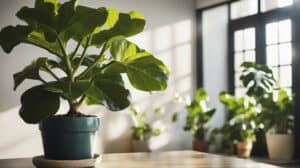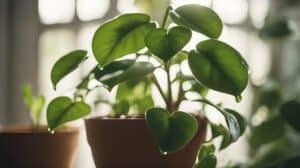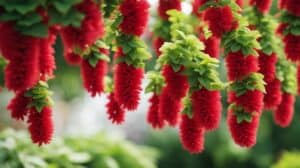Bromeliads are a diverse and fascinating family of plants that are popular among gardeners and indoor plant enthusiasts alike.
Among the most striking and vibrant bromeliads are the Aechmea and Guzmania varieties.
These plants are known for their bold colors, unique shapes, and ease of care, making them a great choice for beginners who want to add some tropical flair to their home or garden.

Aechmea and Guzmania are both native to the tropical regions of Central and South America, where they grow as epiphytes, or plants that attach themselves to other plants or trees.
In cultivation, they are typically grown in pots with a well-draining soil mix and bright, indirect light.
With proper care, these plants can thrive for years, producing stunning flowers and colorful foliage that will brighten up any space.
In this article, we will explore the world of Aechmea and Guzmania bromeliads, including their unique characteristics, care requirements, and tips for growing them successfully.
Discovering Bromeliads
What Are Bromeliads?
Bromeliads are a diverse family of plants that are native to the Americas.
They come in a variety of shapes, sizes, and colors, and are known for their striking foliage and unique flowers.
Bromeliads are epiphytes, which means they grow on other plants, and they are able to absorb water and nutrients through their leaves.
Bromeliads are popular among gardeners and plant enthusiasts because of their low maintenance requirements and their ability to thrive in a variety of environments.
They are also great for indoor cultivation, as they can add a touch of color and vibrancy to any room.
The Aechmea and Guzmania Genera
Two popular genera of bromeliads are Aechmea and Guzmania.
Aechmea plants are known for their spiky leaves and colorful bracts, which are modified leaves that surround the flower spike.
They come in a variety of colors, including pink, red, and orange, and are great for adding a tropical touch to any garden or indoor space.
Guzmania plants, on the other hand, are known for their large, showy flowers and glossy leaves.
They come in a variety of colors, including red, orange, yellow, and pink, and are great for adding a pop of color to any space.
Guzmania plants are also great for indoor cultivation, as they are able to thrive in low light conditions.
Overall, bromeliads are a great addition to any garden or indoor space.
They are easy to care for, come in a variety of colors and shapes, and are sure to add a touch of vibrancy to any environment.
Caring for Your Bromeliads

Ideal Growing Conditions
Bromeliads are tropical plants that thrive in warm, humid environments.
They prefer bright, indirect light, so placing them near a window with filtered sunlight is ideal.
Aechmea and Guzmania bromeliads grow best in temperatures between 60-80°F (15-27°C), so it’s important to keep them away from cold drafts and extreme heat sources.
Watering and Feeding
Bromeliads are epiphytic plants, which means they grow on other plants in their natural habitat.
They absorb water and nutrients through their leaves, so it’s important to keep the central cup, or “tank,” filled with water.
It’s recommended to use distilled or rainwater, as tap water can contain chemicals that may harm the plant.
In terms of feeding, bromeliads do not require frequent fertilization.
A slow-release fertilizer can be added to the central cup every few months, or a diluted liquid fertilizer can be sprayed onto the leaves.
Propagation Techniques
Bromeliads can be propagated through offsets, or “pups,” that grow from the base of the mother plant.
These can be removed once they are at least one-third the size of the mother plant and have developed their own roots.
To propagate, gently separate the pup from the mother plant and plant it in a well-draining soil mix.
Keep the soil moist and in a warm, humid environment until the pup has established its own root system.
Overall, caring for Aechmea and Guzmania bromeliads is relatively easy as long as their ideal growing conditions are met.
With proper watering, feeding, and propagation techniques, these vibrant plants can thrive and add a tropical touch to any home.
Designing with Bromeliads

Bromeliads are not only beautiful on their own, but they can also add a vibrant touch to any garden or interior design.
Here are some tips on how to incorporate these stunning plants into your landscaping and indoor spaces.
Landscape Integration
Bromeliads are versatile plants that can be used in a variety of landscaping designs.
They can be planted in the ground or in containers to create a dramatic effect.
When designing with bromeliads, it is important to consider their size, color, and texture.
Some bromeliads, such as Aechmea fasciata, can grow up to 3 feet tall, while others, such as Guzmania lingulata, stay small and compact.
Mixing different sizes and colors of bromeliads can create a dynamic and eye-catching display.
Container Gardening
Bromeliads are perfect for container gardening.
They can be planted in pots of various sizes and shapes, and can be used to create a beautiful and unique display.
When planting bromeliads in containers, it is important to use a well-draining soil mix and to water them regularly.
Adding a layer of rocks or pebbles to the bottom of the container can help with drainage and prevent root rot.
Indoor Display Tips
Bromeliads can also be used to add a pop of color and texture to indoor spaces. They can be displayed on shelves, tables, or even hung from the ceiling.
When designing with bromeliads indoors, it is important to consider the lighting and humidity levels of the space.
Most bromeliads prefer bright, indirect light and high humidity.
Placing a tray of water near the plants or misting them regularly can help to increase the humidity levels.
By following these tips, anyone can design with bromeliads and create a stunning display in their home or garden.
Frequently Asked Questions

What are the best types of bromeliads for beginners to grow?
For beginners, Aechmea and Guzmania bromeliads are the best types to grow. They are easy to care for and come in a variety of colors and sizes.
How should I care for Guzmania bromeliads outdoors?
Guzmania bromeliads prefer bright, indirect light and well-draining soil. They also need to be watered regularly, but make sure not to overwater them.
In colder climates, they should be brought indoors during the winter months.
Can you provide tips for caring for bromeliads in pots?
When growing bromeliads in pots, it’s important to use a well-draining potting mix.
They should also be watered regularly, but make sure not to let the soil become waterlogged.
Additionally, it’s recommended to fertilize them every two to three months.
What should I do with my bromeliad after it has finished flowering?
After a bromeliad has finished flowering, it will begin to produce offsets or “pups”.
These can be removed and potted separately to grow into new plants. The original plant will eventually die, but the pups will continue to grow.
Is it true that bromeliads bloom only once, and what do I do afterwards?
Most bromeliads do only bloom once, but some types, such as Aechmea and Guzmania, can bloom multiple times.
After blooming, the plant will produce offsets or “pups” which can be removed and potted separately.
The original plant will eventually die, but the pups will continue to grow.
What are the key differences between Aechmea and Guzmania bromeliads?
Aechmea bromeliads have spiky leaves and a tall, upright growth habit. They typically have bright, colorful bracts that last for several months.
Guzmania bromeliads have softer leaves and a more compact growth habit.
They typically have long-lasting, colorful flower spikes that can last for several months.















Add Comment